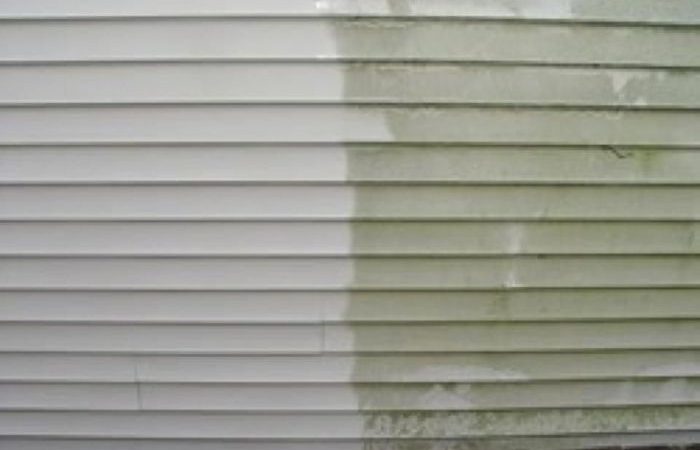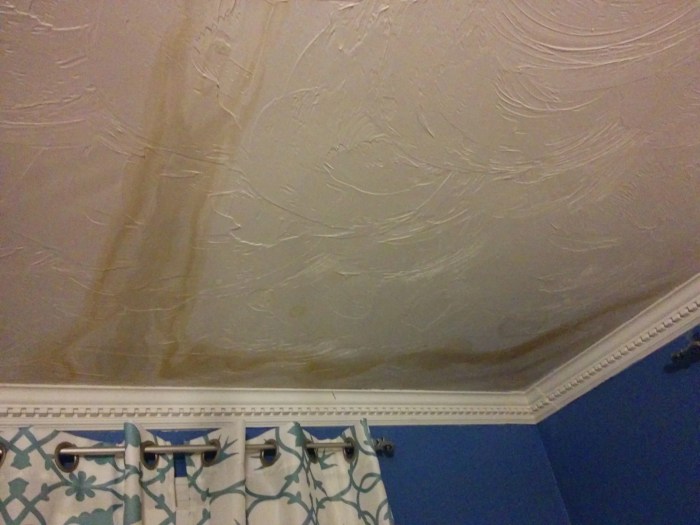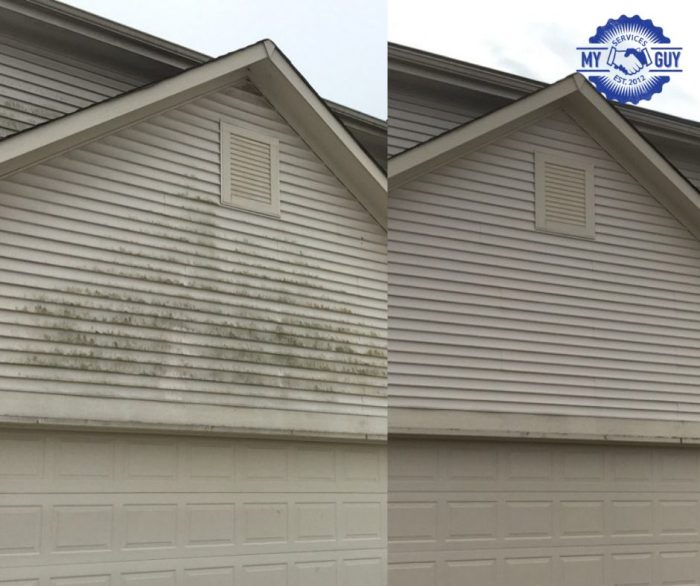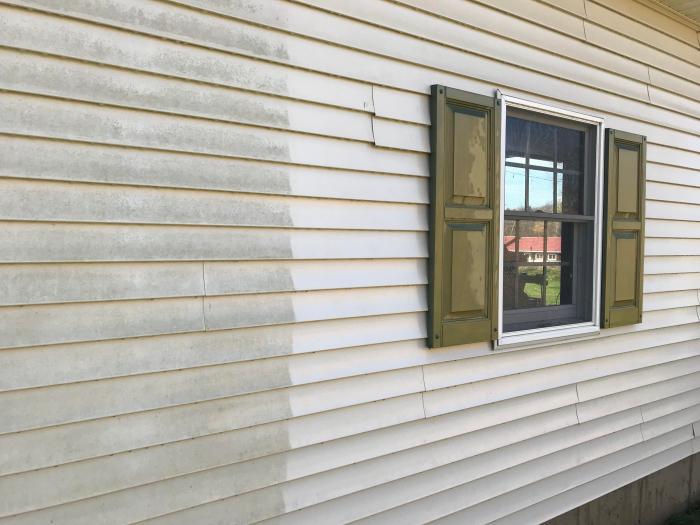Getting Mildew Off Siding A Homeowners Guide

Getting mildew off siding is a common homeowner problem, but knowing how to tackle it effectively can save you time, money, and frustration. Mildew, that unsightly fuzzy growth, can appear on various siding materials—wood, vinyl, aluminum, even fiber cement—and its presence isn’t just an aesthetic issue; it can also indicate underlying moisture problems. This guide will walk you through identifying mildew, choosing the right cleaning method and solution, and implementing preventative measures to keep your siding looking its best and protecting your home’s exterior.
We’ll cover everything from basic cleaning techniques like scrubbing with bleach solutions to more advanced methods such as pressure washing, highlighting safety precautions along the way. We’ll also delve into the environmental impact of different cleaning agents and help you select the most appropriate solution for your specific siding type and the severity of the mildew infestation. Finally, we’ll discuss preventing future mildew growth, ensuring your home stays clean and beautiful for years to come.
Identifying Mildew on Siding

Source: o0bc.com
Mildew on siding is a common problem, but recognizing it early is key to preventing extensive damage and costly repairs. Different siding materials show mildew in slightly different ways, and understanding these visual cues is the first step in effective treatment. Knowing the conditions that encourage mildew growth also helps in preventing future outbreaks.
Identifying mildew requires a keen eye and a bit of detective work. It’s easy to mistake other siding issues for mildew, so a careful assessment is essential.
Mildew Appearance on Different Siding Materials
Mildew’s appearance varies depending on the siding material. On wood siding, mildew often presents as a dark, usually black or grayish-green, discoloration that can feel slightly fuzzy or slimy to the touch. The discoloration may appear in patches or spread across larger areas. Vinyl siding, while more resistant to mildew, can show it as a similar dark discoloration, often appearing as streaks or patches. However, it typically won’t have the same fuzzy texture as on wood. Aluminum siding is less susceptible to mildew growth due to its non-porous nature; however, if mildew does appear, it usually manifests as a dark, slightly powdery residue. Fiber cement siding, a popular choice for its durability, may show mildew as a dark discoloration, similar to wood, but the texture might be less fuzzy. The porous nature of fiber cement makes it more susceptible to mildew than vinyl or aluminum.
Conditions Promoting Mildew Growth on Siding
Several factors contribute to mildew growth. High humidity levels are a primary culprit, providing the moisture mildew needs to thrive. Areas with poor air circulation, such as shaded areas of the house or areas with overgrown vegetation, are also more prone to mildew. Lack of direct sunlight inhibits the drying process, further encouraging mildew growth. Finally, the presence of organic matter, such as leaves or debris accumulating against the siding, provides a food source for mildew spores.
Checklist for Identifying Mildew Versus Other Siding Issues
Before treating your siding, it’s crucial to confirm it’s mildew and not another issue. This checklist can help differentiate mildew from other potential problems.
- Discoloration: Is the discoloration dark, typically black, gray, or greenish? Does it appear patchy or streaky?
- Texture: Does the discoloration feel fuzzy, slimy, or powdery to the touch?
- Location: Is the discoloration concentrated in shaded, poorly ventilated areas of the house?
- Smell: Does the affected area have a musty or earthy odor?
- Spread: Is the discoloration spreading or appearing in new areas?
If you answer “yes” to several of these questions, it’s highly likely you’re dealing with mildew. However, if you’re unsure, consulting a professional is always a good idea. Misdiagnosing the problem can lead to ineffective treatments and potentially further damage.
Cleaning Methods for Mildew Removal

Source: myguyservicesllc.com
Getting rid of mildew from your siding requires choosing the right cleaning method. The best approach depends on the type of siding, the severity of the mildew, and your comfort level with different cleaning techniques. We’ll explore three common methods: pressure washing, scrubbing, and chemical treatments, highlighting their pros and cons and safety considerations.
Pressure Washing for Mildew Removal
Pressure washing offers a powerful way to blast away mildew, especially from large areas. A high-pressure stream of water effectively removes loose mildew and dirt. However, it’s crucial to use the correct pressure setting to avoid damaging your siding. Too much pressure can cause dents, cracks, or even strip away the paint or finish. For vinyl siding, a lower pressure setting is essential. Furthermore, improper technique can lead to water damage behind the siding. Always test the pressure washer on an inconspicuous area first to check for any negative effects.
Scrubbing for Mildew Removal
Scrubbing is a gentler approach, suitable for smaller areas or delicate siding materials. You can use a stiff-bristled brush and a cleaning solution to manually remove mildew. This method allows for more control and minimizes the risk of damage compared to pressure washing. However, it’s more labor-intensive and may not be effective against stubborn mildew stains. A long-handled brush is recommended to avoid excessive bending and stretching.
Chemical Treatments for Mildew Removal
Chemical treatments, such as bleach solutions or commercial mildew removers, are effective in killing mildew and brightening the siding. These solutions often contain chemicals that are potent and can be harmful if not handled properly. Always follow the manufacturer’s instructions carefully, and wear appropriate protective gear, including gloves, eye protection, and a mask. Some commercial products are more environmentally friendly than others; consider this factor when making your selection.
Safety Precautions for Mildew Removal
Safety is paramount when cleaning mildew. When using pressure washers, always wear safety glasses or goggles to protect your eyes from debris and splashing water. Keep a safe distance from the spray nozzle and never point it at yourself or others. When working with chemical solutions, wear rubber gloves, protective clothing, and a respirator to avoid skin and respiratory irritation. Ensure adequate ventilation, especially when using bleach or other strong chemicals. Never mix different cleaning solutions, as this can create dangerous fumes or reactions. Finally, be mindful of your surroundings and any potential hazards, such as electrical outlets or fragile plants.
Cleaning Mildew from Vinyl Siding with Bleach Solution
Cleaning vinyl siding with a bleach solution is an effective method for removing mildew. However, it’s important to dilute the bleach properly and follow safety precautions.
- Mix the solution: Combine one part bleach with three parts water in a bucket. Never mix bleach with ammonia or other cleaning products.
- Apply the solution: Use a long-handled brush or a garden sprayer to apply the bleach solution to the mildewed areas. Work in small sections at a time.
- Let it sit: Allow the solution to sit for 10-15 minutes to allow it to work its magic.
- Scrub and rinse: Use a stiff-bristled brush to scrub the mildew away. Rinse thoroughly with clean water using a garden hose.
- Allow to dry: Allow the siding to dry completely before inspecting the results.
Comparison of Cleaning Agents
| Product | Effectiveness | Safety Concerns | Cost |
|---|---|---|---|
| Bleach Solution (1:3 ratio) | High, effective against most mildew | Can irritate skin and eyes; bleach fumes are harmful; may damage some siding materials. | Low |
| Baking Soda | Moderate; best for light, mildew | Generally safe, but may not be effective against heavy mildew. | Low |
| Trisodium Phosphate (TSP) | High, effective against tough mildew | Can irritate skin and eyes; toxic if ingested; environmentally unfriendly. | Moderate |
Choosing the Right Cleaning Solution
Picking the right cleaning solution for your siding is crucial; using the wrong one can damage the material or be ineffective against the mildew. The best choice depends on your siding type and how severe the mildew infestation is. Consider the environmental impact as well, opting for less harsh options whenever possible.
Effectiveness of Cleaning Solutions on Different Siding Types
The effectiveness of various cleaning solutions varies greatly depending on the siding material. Bleach, while potent, can damage certain siding types, while oxygen bleach is generally gentler. Commercial mildew removers often contain a blend of chemicals tailored for effectiveness, but always check the product label for compatibility with your siding.
For example, wood siding is particularly susceptible to damage from bleach, which can cause discoloration and weakening of the fibers. Oxygen bleach, on the other hand, is often a safer choice for wood, as is a solution of mild dish soap and water. Vinyl siding is generally more resilient and can tolerate bleach solutions, though a thorough rinse is crucial to prevent discoloration. However, even with vinyl, using a gentler solution first is recommended. Brick and stone are usually robust enough to handle stronger cleaning agents, but pre-testing in an inconspicuous area is always advisable.
Environmental Impact of Cleaning Solutions
Bleach is a powerful disinfectant, but it’s also a harsh chemical that can harm beneficial organisms in the environment. Oxygen bleach is a more environmentally friendly alternative, as it is a milder oxidizing agent and breaks down into less harmful byproducts. Commercial mildew removers vary greatly in their environmental impact; some are formulated with biodegradable ingredients, while others contain potentially harmful chemicals. Always check the product label for information on its environmental profile. Consider using less water and only cleaning affected areas to minimize environmental impact.
Decision Tree for Choosing a Cleaning Solution
This decision tree helps you select the appropriate cleaning solution based on your siding material and the severity of the mildew.
| Siding Material | Mildew Severity (1-3, 1 being light, 3 being heavy) | Recommended Cleaning Solution |
|---|---|---|
| Wood | 1-2 | Oxygen bleach solution or mild dish soap and water |
| Wood | 3 | Consult a professional cleaning service |
| Vinyl | 1-2 | Oxygen bleach solution or mild dish soap and water |
| Vinyl | 3 | Diluted bleach solution (always test in an inconspicuous area first) |
| Brick/Stone | 1-3 | Diluted bleach solution (always test in an inconspicuous area first) |
| Other | Any | Consult the manufacturer’s recommendations and/or a professional cleaning service. |
Remember: Always test any cleaning solution in an inconspicuous area before applying it to the entire surface. This will help you assess whether the solution damages your siding and allows you to adjust the concentration if needed.
Prevention of Mildew Growth

Source: redd.it
Preventing mildew on your siding is all about controlling moisture. By minimizing dampness and encouraging airflow, you can significantly reduce the chances of those unsightly black spots appearing. This proactive approach is far easier and cheaper than dealing with a full-blown mildew infestation.
Regular maintenance and a few smart choices in materials can make a huge difference in the long run, saving you time, money, and frustration. Let’s explore some effective strategies.
Improving Ventilation
Good air circulation is key to preventing mildew. Stagnant air traps moisture, creating the perfect breeding ground for mildew spores. Ensure your soffits and fascia boards (the parts under your roof overhangs) have adequate vents to allow air to flow freely through your walls. Properly functioning gutters and downspouts are also essential to prevent water from accumulating near the foundation. Consider adding vents to areas with poor airflow, such as enclosed porches or areas with dense landscaping close to the house. Regularly check and clean your vents to make sure they’re not blocked by leaves, debris, or nests.
Regular Cleaning
Regular cleaning is a simple yet highly effective preventative measure. At least once or twice a year, wash your siding with a solution of water and a mild detergent. This removes dirt, pollen, and other debris that can trap moisture and encourage mildew growth. For tougher stains, you might need a stronger cleaning solution, but always test it in an inconspicuous area first. A pressure washer can be helpful, but use caution to avoid damaging your siding. A gentle spray is better than a powerful blast.
Using Mildew-Resistant Paints and Sealants
Investing in mildew-resistant paints and sealants is a more expensive upfront cost, but it offers long-term protection. These products contain additives that inhibit mildew growth, extending the lifespan of your paint job and reducing the need for frequent cleaning and repainting. When choosing a paint, look for those explicitly labeled as mildew-resistant or with a high level of mildew resistance. Similarly, sealants can protect wood siding from moisture penetration, making it less susceptible to mildew. Remember to apply these products according to the manufacturer’s instructions for optimal results.
Improving Drainage Around the Foundation, Getting mildew off siding
Proper drainage is crucial to prevent moisture from seeping into your walls. Ensure that the ground slopes away from your foundation, creating a slight grade that directs water away from the house. Install gutters and downspouts that extend at least 4-6 feet away from the foundation. Consider adding French drains or other drainage systems if you have particularly poor drainage or consistently high water tables. Regularly check your gutters and downspouts to ensure they are clean and functioning properly. Overgrown vegetation near the foundation should be trimmed back to allow for better air circulation and prevent moisture retention.
Preventative Measures Ranked by Cost-Effectiveness
Before listing preventative measures, it’s important to remember that prioritizing regular cleaning and good ventilation can prevent many mildew issues before they become major problems. Addressing these issues promptly is often much cheaper than dealing with extensive mildew damage.
- Regular cleaning with water and mild detergent.
- Improving ventilation by cleaning existing vents and ensuring proper soffit and fascia venting.
- Improving drainage by grading the soil around the foundation and ensuring proper gutter function.
- Using mildew-resistant paints and sealants for new paint jobs or when repainting.
- Installing more extensive drainage systems (French drains, etc.) if other methods prove insufficient.
Dealing with Stubborn Mildew
Sometimes, a simple cleaning solution just isn’t enough to conquer persistent mildew stains on your siding. This is especially true for older stains or those that have deeply penetrated the surface. Knowing when to call in the professionals and how to tackle the tough stuff yourself is key to restoring your home’s exterior.
Stubborn mildew often indicates a deeper issue, potentially requiring more than just a DIY cleaning solution. This section will help you identify when professional help is needed and guide you on using power washing and applying a sealant for long-term protection.
Situations Requiring Professional Mildew Removal
Persistent mildew, despite repeated cleaning attempts, often signals a problem beyond surface cleaning. Extensive mildew coverage, especially over large areas of siding, might indicate underlying moisture problems like leaky gutters, damaged flashing, or poor ventilation. In these cases, a professional can diagnose the root cause and provide a more comprehensive solution. Additionally, if your siding is made of a delicate material, like some types of wood or composite, professional cleaning is recommended to avoid damage. Finally, working at heights or on large areas can be dangerous; if you lack the proper equipment or experience, it’s best to leave it to the professionals.
Pressure Washing for Stubborn Mildew Removal
Using a pressure washer can effectively remove stubborn mildew, but improper use can damage your siding. Begin by selecting the appropriate nozzle tip – a wide, fan-shaped nozzle is generally recommended for siding to prevent concentrated pressure that could gouge or damage the surface. Always maintain a safe distance from the siding (typically 12-18 inches), and keep the nozzle moving constantly to prevent concentrating the pressure in one area. Start with a lower pressure setting and gradually increase it if needed. Overlap your passes to ensure complete coverage. Remember to always test a small, inconspicuous area first to check for any adverse effects on the siding material. After pressure washing, rinse thoroughly with clean water to remove any remaining mildew and cleaning solution residue.
Preparing Siding for Mildew-Resistant Sealant
Before applying a mildew-resistant sealant, proper surface preparation is crucial for optimal adhesion and long-lasting protection. This involves a multi-step process ensuring the sealant bonds effectively and prevents future mildew growth.
Preparing Siding for Sealant Application: A Visual Guide
Imagine four distinct stages depicted in a series of close-up images.
Image 1: Cleaning: A section of siding is shown, visibly covered in dark mildew stains. The image shows a person carefully scrubbing the siding with a stiff-bristled brush and a mildew-removing solution. The brush is dipped into a bucket containing a clearly labeled cleaning solution. Noticeable suds are visible on the siding, indicating the cleaning solution’s application.
Image 2: Rinsing: The same section of siding is now shown, visibly cleaner, but still damp from the cleaning solution. A garden hose is spraying water onto the siding, rinsing away the cleaning solution and loosened mildew. The water runs down the siding, carrying away the remaining residue. The image emphasizes the thorough rinsing process.
Image 3: Drying: The same section of siding is now completely dry. The siding appears clean and free of mildew. The image emphasizes the importance of completely drying the surface before applying the sealant. Perhaps a slightly sunny day is suggested, highlighting the natural drying process.
Image 4: Sealant Application: The same section of siding is shown with a thin, even coat of mildew-resistant sealant applied. The image shows a person using a paint roller or brush to apply the sealant, demonstrating proper technique. The sealant is visibly covering the siding’s surface, creating a protective layer. The image emphasizes the even and thorough application of the sealant. The sealant’s color should be visible, contrasting slightly with the siding’s color.
Conclusion: Getting Mildew Off Siding

Source: pinimg.com
Conquering mildew on your siding doesn’t have to be a daunting task. By carefully identifying the type of mildew, selecting the appropriate cleaning solution, and following safe cleaning procedures, you can restore your siding’s pristine appearance. Remember, prevention is key! Implementing the preventative measures outlined above—from improving drainage to regular cleaning—will help keep mildew at bay and protect your home’s exterior for years to come. Don’t hesitate to call in a professional for stubborn mildew or extensive damage; they have the expertise and equipment to handle more challenging situations effectively.
Comments are closed.